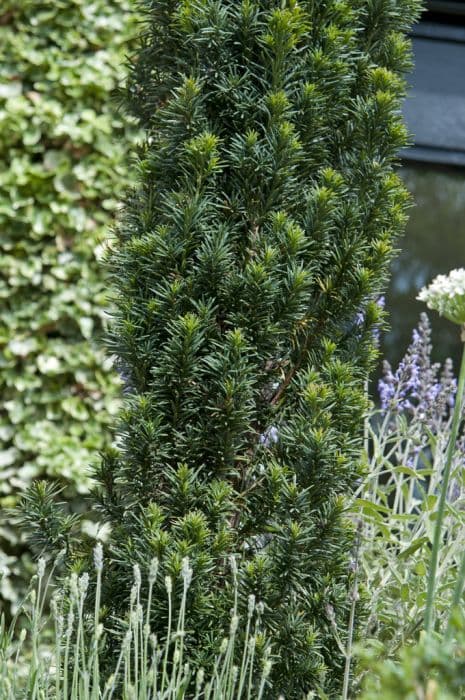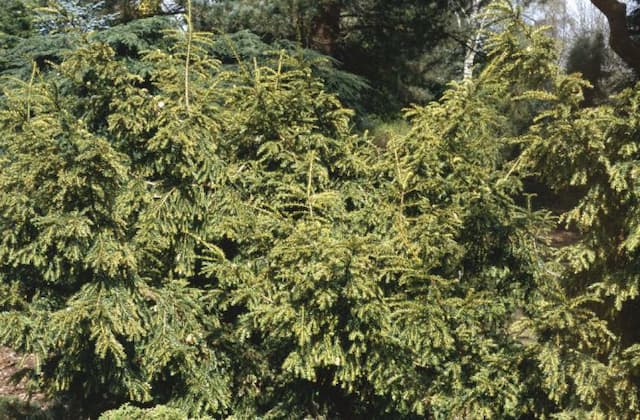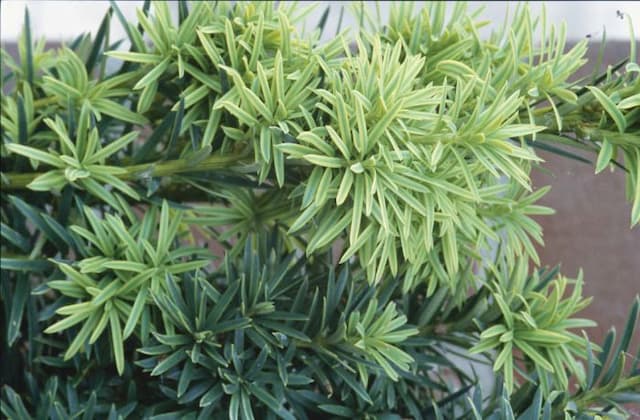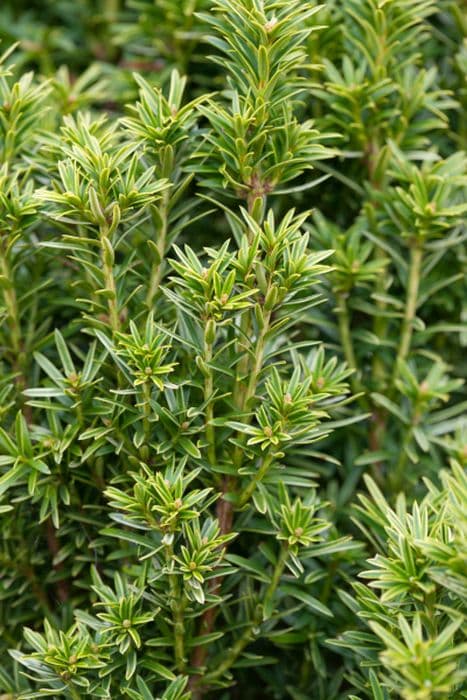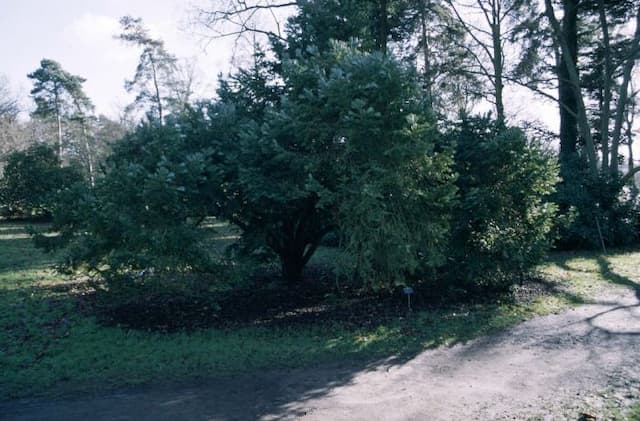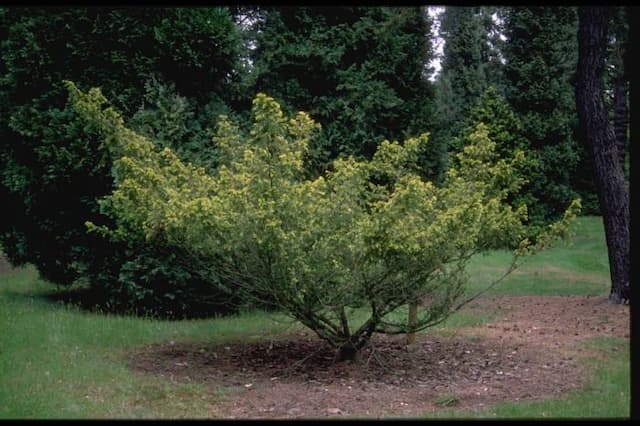English Yew Taxus baccata 'Amersfoort'

ABOUT
The plant known as the English yew 'Amersfoort' has a unique and striking appearance. It exhibits a coniferous form with dense, rich foliage that tends to be dark green in color. The leaves are narrow, small, and spirally arranged, with each individual leaf typically being needle-like in shape, contributing to a fine texture when viewed up close. The plant's overall structure could be described as irregular and sculptural, which allows it to make quite a statement in a landscape. In contrast to the deep green needles, it bears bright red, berry-like structures known as arils. These arils encase the seeds and provide a vivid pop of color against the backdrop of the foliage. However, it's essential to note that despite their enticing look, they contain parts that are toxic if ingested. The English yew 'Amersfoort' is often appreciated for its architectural qualities, with branches that can grow in an undulating or spiraling fashion, sometimes twisting naturally into unique forms. This characteristic makes each specimen slightly different and can add to the aesthetic value of the plant in ornamental settings. The English yew 'Amersfoort' manages to retain its needles throughout the year, making it an evergreen selection that provides color and structure across all seasons. It's adaptable to various pruning practices, which can enhance or maintain its distinct shape, making it a versatile choice for gardeners and landscape designers.
About this plant
 Names
NamesFamily
Taxaceae
Synonyms
Amersfoort Yew, Amersfoort English Yew
Common names
Taxus baccata 'Amersfoort'.
 Toxicity
ToxicityTo humans
The English yew, including the cultivar Taxus baccata 'Amersfoort', is highly toxic to humans. This toxicity is due to the presence of several toxic compounds, most notably taxine alkaloids. All parts of the plant, except the flesh of the red berries, contain these substances, with the seeds being particularly poisonous even when the flesh of the berries is ingested. Symptoms of yew poisoning can include dizziness, dry mouth, dilated pupils, weakness, abdominal pain, accelerated heart rate, trembling, and potentially lethal changes in heart rhythm. In severe cases, poisoning can lead to respiratory failure, heart failure, and death.
To pets
The English yew, including the cultivar Taxus baccata 'Amersfoort', is also highly toxic to pets. The plant contains toxic alkaloids, particularly taxine, which are present in all parts of the plant except for the aril around the seed. If a pet ingests the leaves, bark, or seeds of the plant, symptoms of poisoning can manifest as vomiting, diarrhea, weakness, difficulty breathing, changes in heart rate, muscle tremors, seizures, collapse and potentially death due to cardiac arrest. Prompt veterinary attention is required if yew ingestion is suspected.
 Characteristics
CharacteristicsLife cycle
Perennials
Foliage type
Evergreen
Color of leaves
Green
Height
2-3 feet [0.6-0.9 meters]
Spread
2-3 feet [0.6-0.9 meters]
Plant type
Shrub
Hardiness zones
7
Native area
Europe
Benefits
 General Benefits
General Benefits- Aesthetic Appeal: Taxus baccata 'Amersfoort', also known as the English yew, has a unique, spiral growth habit that can add architectural interest and beauty to landscapes.
- Evergreen Foliage: It provides year-round greenery with its dark green, needle-like leaves, offering continuous color in gardens.
- Wildlife Habitat: It can offer shelter and nesting sites for birds and other small wildlife.
- Low Maintenance: The English yew is relatively low maintenance once established, requiring little pruning or additional care.
- Drought Tolerance: Once established, it is tolerant of drought conditions, making it suitable for drier climates or areas with water restrictions.
- Shade Tolerance: It is capable of growing in shaded areas where other plants might struggle, thus providing landscaping options under tree canopies or in darker garden spots.
- Hedge and Topiary: The plant is often used for hedging and topiary because of its dense foliage and ability to tolerate frequent shearing and shaping.
- Soil Adaptability: English yew can adapt to a wide range of soil types, although it prefers well-drained soils.
- Longevity: It is known for its long lifespan, with some individual trees living for several centuries, thereby offering a long-term presence in any planting scheme.
- Berries for Birds: Although the seeds are toxic to humans, the red berries produced by the female plants are a food source for certain bird species.
- Windbreak: When planted in rows or groups, English yew can act as a windbreak, protecting gardens and structures from strong winds.
- Privacy Screen: Its dense growth habit provides an excellent privacy screen, helping to create a secluded atmosphere in residential gardens.
- Noise Reduction: The dense foliage can also help to dampen noise pollution, creating a more tranquil garden environment.
 Medical Properties
Medical Properties- The European yew (Taxus baccata) contains compounds such as taxines which are toxic and can be lethal if ingested.
- Biomedical research has isolated and used taxol (paclitaxel) which is derived from the bark of various Taxus species including T. baccata, although it is primarily extracted from the bark of the Pacific yew (Taxus brevifolia). Taxol has significant medical properties and is used as a chemotherapy medication to treat several types of cancer.
 Air-purifying Qualities
Air-purifying QualitiesThis plant is not specifically known for air purifying qualities.
 Other Uses
Other Uses- Topiary and Bonsai: Taxus baccata 'Amersfoort', commonly known as the English yew, is often used for topiary and bonsai because it responds well to pruning and can be shaped into various forms.
- Archery Bows: The wood of English yew has historically been used for making longbows due to its combination of flexibility and strength.
- Cabinet Making: The fine grain and durability of English yew wood makes it a prized material for furniture making, particularly for decorative cabinets and veneers.
- Tool Handles: Tools that require strong, durable handles like chisels and hammers are sometimes made with English yew wood for its robust properties.
- Turnery: The consistent texture and workability of English yew wood make it suitable for turnery, creating beautifully crafted wooden items on a lathe.
- Wooden Sculpture: English yew is chosen by some sculptors for its workability and appealing color variation, from pale to darker hues.
- Soundboards in Musical Instruments: Its resonance properties allow English yew wood to be used in creating soundboards for certain musical instruments.
- Traditional Folklore and Symbolism: English yew is often associated with longevity and rebirth, making it a symbolic plant in various cultural traditions and ceremonies.
- Garden Focal Points: With its striking appearance, English yew can be planted to create eye-catching focal points in landscape design.
- Wildlife Shelter: Birds and other small animals use English yew trees for shelter and nesting, contributing to the biodiversity of an area.
Interesting Facts
 Feng Shui
Feng ShuiThe European Yew is not used in Feng Shui practice.
 Zodiac Sign Compitability
Zodiac Sign CompitabilityThe European Yew is not used in astrology practice.
 Plant Symbolism
Plant Symbolism- Eternity: Taxus baccata, commonly known as the yew tree, is a symbol of eternity due to its longevity and the fact that many yew trees live for hundreds, sometimes over a thousand, years.
- Resilience: The yew tree is incredibly hardy and can grow in a variety of climates and soils, symbolizing resilience and adaptability to circumstances.
- Death and Rebirth: Yew trees are often found in graveyards and have been historically associated with death, but as evergreens, they also represent rebirth and the cyclical nature of life.
- Transformation: The capacity of the yew to regenerate by sprouting from cut branches and stumps is a powerful symbol of transformation and renewal.
- Protection: The wood of the yew tree was used to make bows and arrows in ancient times, leading to its association with protection and defense.
 Water
WaterThe English Yew requires consistent moisture, but it’s crucial not to overwater. During the growing season, watering should be thorough, so the soil becomes moist but not soggy. Aim to water deeply once a week, providing the English Yew with about 1 to 1.5 gallons of water each time, depending on the weather conditions. During hot, dry periods, the frequency may need to increase to twice a week. In the winter months, reduce watering to when the soil is dry to the touch, as the plant's water requirements decrease.
 Light
LightEnglish Yew thrives in full sun to partial shade. It will perform best when it receives at least four to six hours of sunlight a day. However, the plant is adaptable and can tolerate a spot with more shade. For optimal health and growth, a location that provides morning sunlight and afternoon shade would be ideal.
 Temperature
TemperatureEnglish Yew is hardy and can tolerate a wide range of temperatures, thriving best when the temperature is between 60°F and 70°F. It can withstand winter temperatures down to about -30°F and summer temperatures up to 90°F. To maintain its health, avoid exposing the English Yew to extreme temperature fluctuations.
 Pruning
PruningPrune the English Yew to maintain its shape and remove diseased or damaged branches. Best done in late winter or early spring before new growth starts. Yews respond well to pruning so they can be trimmed annually. For shaping or size control, it's safe to cut back branches to old wood as yews can produce new growth from old wood.
 Cleaning
CleaningAs needed
 Soil
SoilEnglish Yew 'Amersfoort' thrives in well-draining, loamy soil with a pH of 6.0 to 7.5. The best soil mix for this conifer is one part garden soil, one part peat, and one part perlite or coarse sand to ensure proper drainage and aeration.
 Repotting
RepottingEnglish Yew 'Amersfoort' should be repotted every 3 to 5 years. Since it is a slow-growing conifer, frequent repotting is unnecessary unless the plant has outgrown its current container.
 Humidity & Misting
Humidity & MistingEnglish Yew 'Amersfoort' tolerates a wide range of humidity conditions but prefers moderate humidity. It can adapt to both dry and moist atmospheres, making it versatile for various environments.
 Suitable locations
Suitable locationsIndoor
Keep in bright, indirect light; avoid hot, dry conditions.
Outdoor
Plant in partial shade, shelter from strong winds, mulch well.
Hardiness zone
5-7 USDA
 Life cycle
Life cycleTaxus baccata 'Amersfoort', commonly known as the Amersfoort yew, begins its life cycle with seed germination, which is relatively slow and may require two to three seasons, as yew seeds have a hard, waxy coat that impedes water absorption. After germination, the seedling stage is marked by the development of a taproot and a few needle-like leaves. The juvenile phase follows, during which the plant exhibits rapid growth and the formation of its characteristic dark green foliage. As the Amersfoort yew matures into its adult phase, it develops a dense, conical shape, and it's known for its tolerance to heavy pruning, allowing for topiary or hedge use. Reproductive maturity is reached after several years, when it produces red, cup-shaped arils containing seeds, which are primarily dispersed by birds. The yew can live for many centuries, with a slow growth rate throughout its life.
 Propogation
PropogationPropogation time
Late Winter-Early Spring
The English yew 'Amersfoort' is typically propagated through cuttings, which is the most popular method for this cultivar. To do so, semi-hardwood cuttings are taken from the current year's growth in late summer or early autumn. A cutting of approximately 4 to 8 inches (10 to 20 centimeters) in length is selected and treated with rooting hormone to stimulate root development. The base of the cutting is then inserted into a pot with a well-drained substrate, such as a mix of peat and perlite or sand. The pot is kept moist and in a protected environment, like a greenhouse or cold frame, to encourage rooting without the exposure to extreme temperatures. Developing a strong root system can take several months, after which the cutting can be transplanted to its permanent location.
